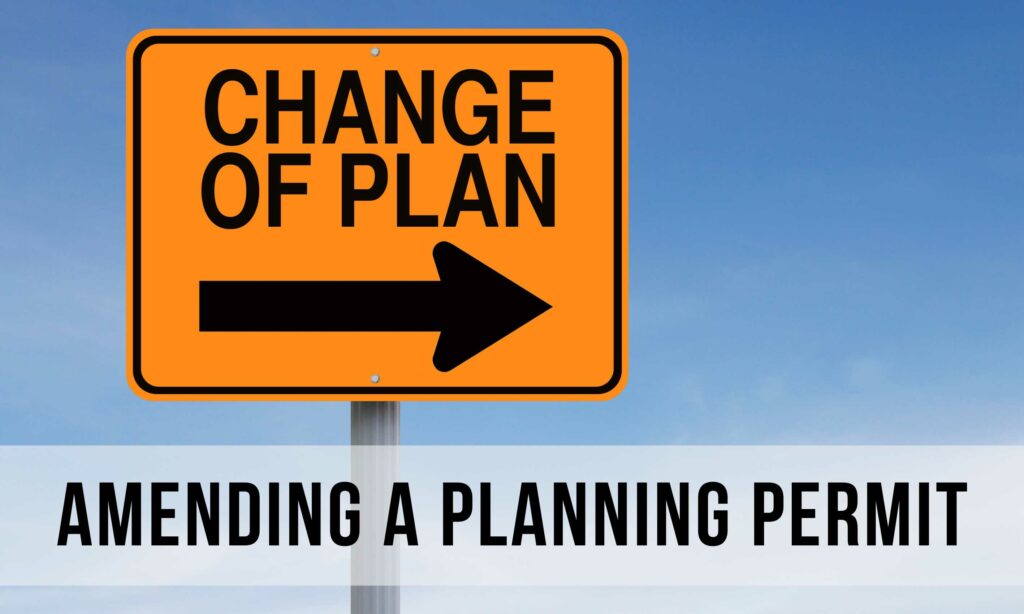29 May Amending Your Planning Permit

Once you get your planning permit with endorsed plans, you need to develop in accordance with those plans. However, as we all know, despite the best of intentions things change sometimes. The plans you make sometimes have to change to fit in with new goals or other changes such as a different builder has new ideas on what to do. For this reason it is possible to apply to amend your plans or permit after it has been approved.
You can make changes by putting in a request to amend the plans or the planning permit. Depending on what you are wanting to do there are two processes with the Council which I will explain below.
Secondary Consent
This is a simple process that has been created to deal with really minor alterations to the plans. Think things like a reduction in building height, replacing/removing a window, alterations to the colours or building materials. That type of thing. These are changes that don’t affect the overall proposal and don’t impact on other properties. This is important because Secondary Consent applications don’t get advertised, this is what makes them a simpler and faster process. Because of this, the Council will determine if the changes are minor enough not to need advertising and on that basis will either agree for the application to be done under Secondary Consent or not.
If it can’t be done under Secondary Consent then it will be done under the other option, an Amendment.
Amendments
The Amendment process allows you to request changes to the planning permit and/or the plans. The Amendment process will be very similar to the original application, including going out to advertising and to other departments for comments if necessary. Due to this we find that an amendment application can take a similar time as a new planning application. The time the amendment is likely to take will also depend on the complexity of the project and the changes being proposed.
Under this process you can potentially make quite big changes such as completely redesigning a house or changing the preamble, which describes what the permit is approved for. This isn’t always practical though, so it is a good idea to get advice on what is best.
When is it Better to go With a New Application Instead of an Amendment?
Not all changes that you might want to do are best done as an amendment. It is important to remember that all the other parts of the planning permit, including other conditions will continue to be a part of the permit. Sometimes the changes you want to make will be too complex or could impact on other parts of the planning permit and it may be less of a hassle to start fresh. If the changes you are wanting to do are really big it would be worth discussing with the Council or your town planner what the best process might be. In some cases it might be cleaner just to start again. As the process with an amendment is basically the same as a new application, there isn’t really any point in over complicating the outcome by doing an amendment if a new planning permit would be better for you. You can have multiple “active” permits for the one site so there is no need to cancel one before starting again. Even if it is a new application, the fact that there is a current approved permit can also work in your favour when the Council is making the final decision. If they deem that the outcome will have a similar or lesser effect on the area then it is logical that it should be approved.
How to Apply For a Planning Permit Amendment
Many Councils now have online portals for lodging planning applications, and this includes for amendments as well. If there is a portal you just need to select the type of amendment (either Secondary Consent or Amendment), detail the changes that you are making, submit the plans and information and pay the required fee. If the Council doesn’t have an online portal they usually have application forms on their website for you to fill out. You would then need to email or send in the application form with all the other information such as plans and details of the changes. Sometimes I manage applications that involve many small changes to the plans. I find it useful to succinctly list all changes (and which plan/s as applicable) to help the Council will noting and assessing everything as quickly as possible. I know from my time working at a Council that reviewing plans with 10 or 20 changes can get confusing really quickly without a handy master list of changes!
My last piece of advice is to consider what is the best timing for your amendment. If the changes you want to do don’t affect the initial building works it may be better to get started with the approved plans and then seek the changes while the building work commences. Of course, this doesn’t always work as sometimes the changes are fundamental to the initial building works, but can be a time saver for some projects.
Need help managing an amendment to your plans or permit? Contact us today.

